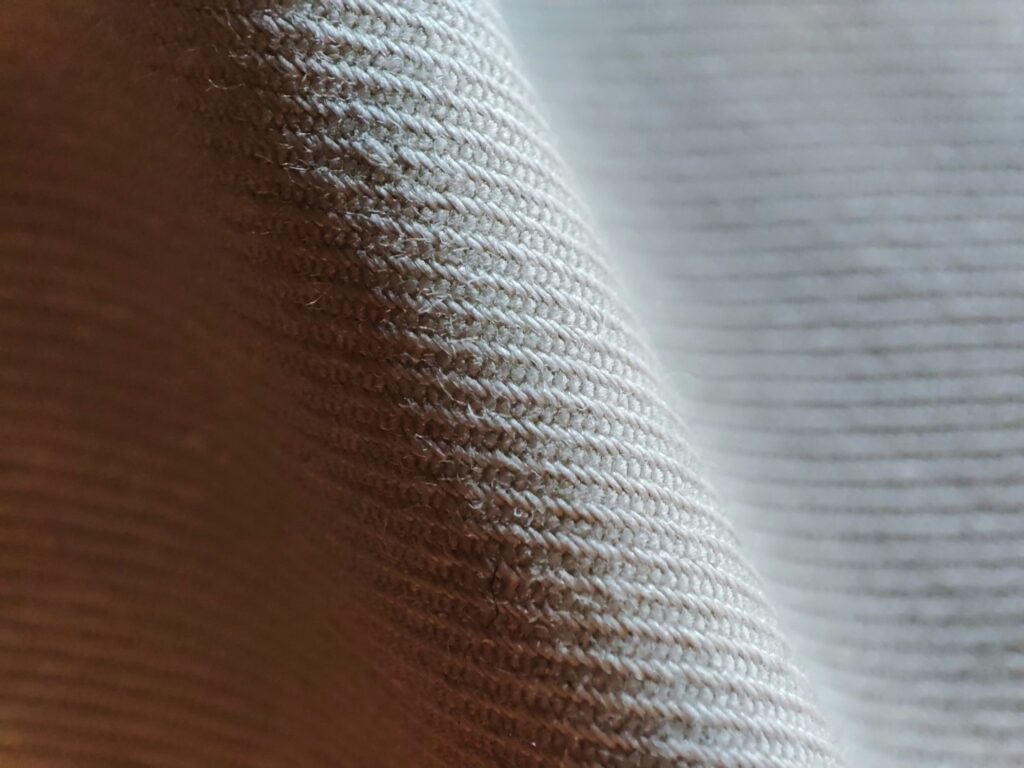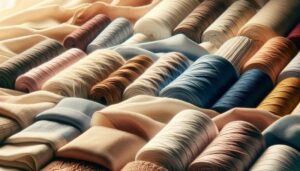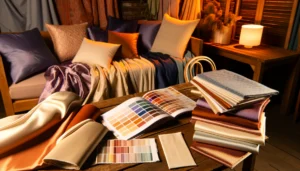If you want to buy high-quality bed sheets, then you should know the term thread count. It refers to the number of threads on a fabric of a certain area. You can think that the higher the thread count, the stronger and better quality the bed linen. But this is not always true. When selecting bed linen, you should consider many characteristics of the fabric in addition to the thread count. Only after carefully studying the topic you can choose bedding that fully suits your needs. Let’s figure out what thread count on sheets is the best and what else you should consider when picking the bed linen.
Table of Contents
What Is Thread Count?

First, you need to understand the thread count sheet meaning. The definition of “thread count” is simply an indicator of the density of the fabric, namely the number of threads in one square inch. The vertical (warp) and horizontal (weft) weaves of the fabric are counted to determine the thread count.
Thread count is calculated by counting the total number of threads in both directions and summing them up. For example, a fabric with a thread count of 200 would typically consist of 100 vertical threads and 100 horizontal threads per square inch.
A high thread count often indicates a finer yarn. More thin threads can be laid per square inch than thick ones. As a result, a high thread count is associated with high-quality fabric. It is believed that finer yarns make bedding softer and more durable. But there are still other factors, such as fiber quality and weave, that are more important when choosing home textiles.
The Myth of High Thread Count

Many bed linen buyers often focus on the density of the material. It is characterized by the number of threads. If you think that the higher the thread count, the better the bedding, you are mistaken.
Let’s give an example. Imagine that you are buying a car. You wouldn’t select a car based only on its mileage. This is wrong because you also need to find out the make, model, and year of manufacture. The same goes for bed linen. Thread count means nothing if you don’t consider other important characteristics.
Without understanding the details, buyers focus only on the largest number of threads. In this case, you do not take into account the quality of the material or the number of layers. It doesn’t take an expert to understand that the quality of bedding made from organic cotton and man-made processed materials will be dramatically different. No amount of thread count will make a difference in such a case.
The concept of thread count is only useful for single-ply cotton sheets. For any other material, it is completely meaningless. On the contrary, a large thread count can play a very cruel joke on you.
To understand why, you need to know a little about textiles, starting with what single-ply cotton means. The layering of a fabric refers to the number of individual threads twisted together to make each thread. A single-ply thread consists of one thread, a two-ply thread consists of two, and a three-ply thread consists of three. Therefore, single-ply cotton sheets are made from single-ply cotton threads.

The finer the threads, the more they can be accommodated in a woven fabric, and the smoother the fabric will feel to the touch. But at some point, it becomes impossible to make a single strand of cotton finer, which means there is a hard limit on the number of strands that can be woven together. For single-ply cotton, this limit is about 400 threads per square inch.
For synthetic fabrics sheet thread count highest is much more. Some synthetic materials are designed with extremely fine threads specifically to increase the thread count for marketing purposes. In addition to the fact that many synthetic fabrics are very thin, they are also multi-layered, which some manufacturers use to further increase the thread count.
For example, when using 3-ply threads, a set of sheets with a 300 thread count can suddenly become a set with a 900 thread count. This number looks much nicer on the label. The problem is that the thread count is not regulated by anyone, so this is the case. No one will actually check what number of threads the seller indicated on the package and whether this indication is true. In general, it is not necessary to indicate the thread count. Therefore, most manufacturers skip this point.
If you take into account the many different types of synthetic weaving (for example, microfiber), the number of threads can become even greater. This is why the vast majority of ultra-high thread count sheets are designed from such materials as polyester or a cotton/polyamide blend.
It is not the buyer’s fault for not understanding the quality of bed linen. Bedding manufacturers have an incentive to avoid informing consumers. This way, companies can make bedding as cheaply as possible, increase sales, and create the illusion of high quality while making a profit. Carefully study the topic related to linen quality and thread count to become a responsible buyer.
Please note that high-quality bedding should also allow sufficient air to pass through. If you find yourself feeling too hot or too cold at night, consider getting new sheets. To purchase truly high-quality bed linen, study all the information provided by the manufacturer on the packaging.
Optimal Thread Count for Bed Sheets

Talking about what thread count on sheets is the best, you should consider the type of fabric. If you want to buy high-quality bedding that is durable, but at the same time soft and comfortable, you can follow the recommendations of the American National Sleep Association:
- 200−400 thread count is applicable for most cotton fabrics.
- Egyptian cotton should have 300−400 TC per square inch.
- 300−500 TC is a good number for fabrics made of bamboo fiber;
- For linen fabrics, there should be an 80−140 thread count.
If this characteristic is not indicated on the package, we can conclude that the manufacturer is conscientious. You should only buy bed linen without proper information on the packaging if you are absolutely sure of its quality. For example, you have previously purchased products from this manufacturer.
How to Choose the Best Thread Count for Your Needs

What is the best thread count on bed sheets? When choosing bed linen, you should answer not only this question. Although thread count plays an important role when selecting bedding, there are other important details to consider when purchasing. Single-ply sheets with 200-400 thread counts feel softer and nicer to the touch and will last longer than multi-ply and high-thread count cotton sheets.
Most experts say that the optimal number of threads for sheets is 200-400 regardless of the material. Typically, sheets in this range are soft and durable. If the thread count is lower, the sheets will not wash well. Materials with a high thread count are usually stiff. But thread count is not the only thing to consider if you want to buy quality bedding.
The place of origin and production of the fabric also affects the quality. For example, sheets made from cotton, which is sourced from Portugal, meet high manufacturing standards. Bed linens created with this level of expertise usually meet regulatory requirements and have environmental certifications, which ensure that the sheets do not contain any harmful chemicals such as dyes and bleaches.
Interestingly, it is not the thread count that makes hotel sheets so luxurious and durable, but the type of weave. Most hotels prefer to use percale sheets with a thread count of 400-500. They are believed to fit most guests’ preferences and will remain in good condition despite extensive washing.
Percale itself is a simple weaving technique of one strand on top and one strand underneath, resulting in a matte finish. This material is very pleasant to the touch. It is the weaving technique that creates the feeling of freshness and high quality of hotel bed linen.
What type of sheets are the best quality? Cotton is often used to make bed linen. This material is highly breathable, soft, durable, and easy to care for. The highest quality cotton is made from long fibers spun into a weave of about 400 threads.
Egyptian cotton is considered one of the best. But there are other options. Linen is becoming one of the most popular sheet materials due to its light feel to the touch and elegant appearance. The thread count may be lower. But the material becomes softer with each wash. Linen has also proven itself to be durable.
Remember that not only high-quality bedding is important for healthy sleep. Start by purchasing a comfortable mattress and pillow and then choose suitable sheets using our tips.
Understanding Different Materials and Weaves

When purchasing bed linen, there is the material of bed sheets and thread count and several other important parameters to consider:
- Fiber type. Regular 100% cotton shows the best combination of price and quality. But there are also premium varieties, such as the long-fiber Egyptian Mako. You can also find cotton-polyester blends that cost less but don’t hold up to intensive washing and look and feel unnatural.
- Weaves. The type of weave greatly influences the feel of the bedding fabric. Typically you choose between percale and satin. Percale is a basic weave similar to mesh. Satin is a soft and smooth weave with thin and twisted transverse threads.
A number of yarn layers. There are single-ply, 2-ply and 3-ply yarns. The fabric can be formed by either single threads or twisted together to form bundles.
For example, a single ply of thick threads will feel different than a double ply of thin threads. According to the established international standard, it is not single threads that are counted, but bundles. However, this does not prevent cunning marketers and unscrupulous sellers from attributing an extra 200-300 threads.
The Highest Thread Count: Is It Worth It?

The number of threads matters to some extent. Generally, a higher thread count equals a softer fabric. The number of threads should be within the normal range, from 200 to 400. If the number is less than 180, then if you lift the sheet to the light, you will see tiny holes, which is not good. Answering the question “What is the highest thread count in bed sheets?”, we should say 400. But you can only say for sure if you know the type of fabric.
An incredibly high thread count is a marketing trap. A sheet with a 1000 thread count is of lower quality than a sheet with a 300 thread count. To achieve a very high thread count, manufacturers use multi-ply yarn, twisting many individual threads around each other. Low-quality multi-ply threads twisted together create heavier, thicker, and less durable bedding.
The number of layers is often a better indicator of bedding quality than the TC itself because it explains exactly how the TC rating was achieved. You should avoid sheets made of fabric with more than two layers.
Instead of paying more for the original quality threads, many manufacturers inflate the thread counts by using cheaper multi-ply yarns. Thus, a 600-thread count fabric often means a three-ply construction of 200 threads per square inch. This is why high thread counts are a myth about bedding.
FAQs on Thread Count and Bed Sheets

How to Understand How Many Threads Are in Bed Linen?
What is the best thread count on bed sheets and how to count them, you may ask? Imagine 120 threads lying in parallel. Place another 120 threads crosswise on top of them. Count the total number of threads per square inch (120+120 = 240). This will be a number of bed linen threads, namely 240 TC. It is impossible to calculate this indicator yourself. Therefore, you should choose bed linen from reliable manufacturers who always provide accurate information on the packaging.
What Thread Count is Considered Good?
According to reviews, the most popular bedding is with a thread count of 300 to 450. Sheet thread count highest up to 500 is not always better. So don’t be too happy when you see a thread count of more than 500. Most often, this is a ploy by sellers. But you can still find quality sheets with a thread count of less than 300. While tests have shown that a thread count range of 300 to 450 is optimal, the type of material is more important.
What Should You Pay Attention to When Buying Bedding Other Than the Thread Count per Square Inch?
When choosing bed linen, in addition to the quality of bed sheets and thread count, ask the seller about the thickness of the threads, weaves, and the number of yarn layers. Only by assessing all the parameters together, you can purchase a quality product.
Do Weaving Techniques Affect the Thread Count in Sheets?
Different weaving techniques can affect the thread count and texture of bed linens. Two popular methods are percale and sateen. Percale weaving represents a tight pattern that offers a crisp texture and. It typically has lower thread counts. Sateen weaving creates a silky finish with a softer feel and is commonly used for sheets with higher thread counts.
How Does Thread Count Affect the Breathability of the Sheets?
The thread count of bed linens can impact the breathability of the material. Sheets with a higher thread count and tighter weave may hinder breathability, possibly retaining more heat. On the other hand, sheets with a lower thread count and looser weave can enhance airflow and breathability, making them ideal for hot sleepers or warmer environments.
Conclusion: What Thread Count on Sheets is the Best

Unless you know what you’re looking for, thread count is a mostly meaningless marketing tool. You don’t need to be an expert in textile design to buy quality bedding, but it’s still useful to know a little information about fabric characteristics. This is the only way you can make the right choice.
The number of threads is not as important as the quality. Organic cotton is softer and safer than conventional cotton. So if you want to sleep on natural, healthy, high-quality sheets, choose long-fiber organic cotton.
If you prefer cotton bedding, keep in mind that a high thread count does not always mean better quality. For example, light and airy cotton percale typically offers a quality 100 thread count maximum. Cotton sateen is denser and smoother with a thread count of 250 to 400.
Now you know how the thread count affects the quality of bed linen. Carefully choose your sheets, and you will be guaranteed a healthy sleep.


